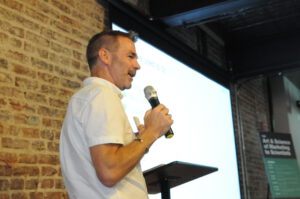Jim Regan is the Director of Marketing at Aptuit, a drug design and discovery pharmaceutical services company. At Aptuit, he implemented a holistic inbound marketing strategy overhaul, tailored around detailed persona constructs and targeted business development, to significantly increase content impressions, lead conversions, and eventually, sales. In our conversation, he shares his most critical insights and guidelines for marketers to successfully implement inbound tactics as either a primary or complementary marketing tool.
C&EN Media Group: Customers have more information and more tools than ever, so we need to approach our processes somewhat differently. Given that customer engagement has changed, what do customers of life sciences and instrumentation-oriented companies fundamentally want?
Jim Regan: If I could deduce exactly what customers want, I would write that every single day. So in some ways, I would approach this from a different angle and say, “What don’t they want?” Certainly, they don’t want to be sold to. They can always go on your website to find a list of features or services. What they need are answers to very specific questions. That’s how people research their vendors now: asking questions rather than just looking for providers of a particular service. Marketers need to address this need and avoid disengaging customers.
C&EN: Your metrics for increasing leads and impressions at Aptuit are very impressive. What was your strategy? And what were the biggest things that ultimately fueled marketing success?
Regan: The marketing department at Aptuit had been reduced in size and functionality, but what they were also doing is allocating equal marketing bandwidth to all departments and personnel. So I came in and did a large-scale overhaul: We stopped trying to be everything for everyone. And we focused on marketing collateral that would give us the most bang for our buck.
Content marketing isn’t anywhere near saturation… this will be true as long as our potential customers have questions.
Before we started to create any content though, we established whom to target and where we could derive our biggest asset growth. Once we’d chosen what and who we were going to chase, we got a diverse group from our company from operations, commercial, sales, and marketing, and brought them into a room for the day to create personas, a set of personalized characters based on real customers. What are their challenges, what makes them look good, what kind of background do they have, where do they get their information? And everything we do from then on is built to address those questions or those personas.
For instance, we may have a buyer in a small biotech industry in North America. Or we’ll have another persona that is C-level, a former scientist, who is now responsible for budgetary management. These two people are going to be researching in different ways with a different set of questions. We’re only going to get an increase in web traffic, and subsequently, in the leads, if they can find us.
C&EN: What’s a channel where they’ve been able to find you?
Regan: At Aptuit, we found a lot of our customers use LinkedIn, and so we place our content in specific groups. About 30% of our new leads comes in via LinkedIn. It shows us the personas actually work and this is where they go to seek information. Logically, you have to continue to put information there for them.
C&EN: Can you explain more what you mean by ‘stop trying to be all things to all people’?
Regan: Every single department and division in a big company believes they are equally important, and therefore should be promoted equally. In actuality, that’s not the case. There can be some departments or divisions that exist because our customers simply expect us to have them – or they’re useful to service another department. But Department A may contribute 1% of our overall revenues, whereas Department B contributes 50%. In the past, we were giving them equal marketing efforts. So I evaluated where we have the greatest opportunities for business revenue, and focused resources on them.
C&EN: Along those lines of trying to do everything, has content marketing gotten to that point of saturation where it’s either being misused or overused?
Regan: A lot of people are misusing content marketing or just not doing it correctly. They take some sales sheets from the past, reformat them, and now think it’s a good piece of content. But it’s still sales material. And we’ve established that people don’t like being sold to.
Content marketing isn’t anywhere near saturation, though, and I really do believe this will be true as long as our potential customers have questions. Plus, their questions will change. For example, in our industry, regulation can change. There may be new studies that have to be conducted on compounds. There will always be an opportunity for us to continue to create content.
I know, ultimately, our idea is to sell things. But, we sell things through building credibility, building relationships and building trust, and by creating content that addresses people’s challenges, their issues, and answering their questions. Luckily the need for this content will only increase when bad or overused content increases.
C&EN: What traditional sales tactics do you incorporate? How does that balance between inbound and outbound work?
Regan: I look at inbound marketing as a tool. It’s not a magic bullet that’s going to cure all our marketing woes and concerns. The same goes for outbound marketing, so you must use both of them side by side. One, in isolation, isn’t what you should be doing. But ultimately, the purpose of everything we do is to build a persona. Before we do any content marketing, or content creation, we need to figure out the main tenants of our customer base. That is the bedrock of what we do.
C&EN: Then outbound marketing, – demos, going to trade shows, follow up calls, – are still valuable after you’ve been able to deploy the above strategy?
Regan: I look at the marketing funnel, and which tools best fit each end. Inbound works well at all stages, but there are times when a demo is necessary. One of our main sites is in Verona, Italy, and it’s not always easy to get people out there. We’ve used video quite extensively to demonstrate their capabilities. For example, if a customer was having issues with the HPLC, we could show them how we were packing the column, and walk through it in detail. You could technically say that’s inbound, because you’re having discussions about new technologies and you get it online, but it’s customer service at its core.
I still think a lot of the physical, in-person strategies are quite important, like going to exhibitions and events. Not necessarily because you’re going to get a big return on your investment, especially in our industry where the sales cycle can be quite long and involve many stakeholders. But you can still influence a core group of people, and it’s always good to engage directly with your customers.
C&EN: Analytics and research shows inbound strategy can be quite effective, but it takes time and patience, particularly with the long sales cycles you mention. How do you advocate balancing patience with results, and what are some hallmarks that suggest a need for strategic course correction?

Regan: You should embark on an inbound strategy with the mindset that this is not an overnight success. It does take time. And you must get that buy-in from others in your organization, as well. Give them case studies that demonstrate content marketing works.
While you can’t pinpoint a date and say, “This is when I should get results,” here at Aptuit we set up a measurement dashboard that reports traffic and leads on a regular basis. We also back that up with information on where traffic is coming from: referrals, keyword success, and A/B test results. What happens when we change an image, or a subject line? If we’re more conversational versus formal? When we see that one choice is winning out over the other, then we choose that one for the overall strategy. Even when we’ve already got a successful page, we’ll do an A/B test to see if we can make it more successful.
C&EN: If I were currently employing purely traditional marketing strategies at my company, and trying to make the switch to inbound, I’d feel really overwhelmed. Any recommendations for basic building blocks to start with?
Regan: You’re absolutely right – it can be overwhelming! Continue with current strategies, but looking purely at content marketing, stick to the basics. Know your objective, know your targets, build personas, and answer what those people’s challenges are. Get your sales and operational teams to tell you about the customers’ common complaints, and then you can start to build content around that.
Give this strategy the proper context and audit your resources. Do you already employ skilled content producers? Do you have the time to produce content? And be honest with yourself. If you don’t have the time or the people, are you willing to invest and hire an agency or a freelancer? You must do these audits to find out where you stand before you start.
Know your objective, know your targets, build personas, and answer what those people’s challenges are.
Assuming the answer to some of those questions is yes, next I would do an audit of prior work. There’s a good chance you already have a lot of content, and that will save you a lot of time and a lot of effort. You’ve probably already amassed case studies, presentations and event talks. You can easily repurpose them into a webinar or an article or a podcast discussion.
C&EN: When you’re starting from scratch, initial success can seem ‘easy’. What does sustained success look like then after you’ve achieved concrete results? How do you build on this when maintaining status quo of this program already takes up a lot of bandwidth?
Regan: First, you should have a number of different measures of success. We set ourselves monthly goals for traffic, blog leads, social media engagement, and conversions. For instance, our baseline is now a minimum of 10,000 site visits per month. If it looks like we’re not getting there, then our team attempts to drive traffic: They start to look at optimization, distribution, the types of content we’re releasing, and asking if there are any adjustments we can make.
We also keep revisiting our personas. Personas don’t live in a vacuum. They can change because the industry might change, regulations may change, the economy changes, but also, technologies change, social media platforms change, online presence changes. And on and on.
Looking ahead, we are driving new inbound projects by incorporating far more video than we’ve ever done before, because we’re realizing that’s what more and more of our customers prefer. If we can put a 90 second video in front of them, people engage with it and then move on to more detailed content. So part of getting beyond the status quo is simply changing the status quo.
The main takeaways
Jim’s marketing strategy is built on the holistic goal of making sure that all content, websites and landing pages are optimized so they can easily be found by customers. In order to cultivate that specificity, he starts by building personas to represent buyers and their needs and challenges, then produces content to address those challenges, versus selling features or a service. Finally, optimize content to be distributed to the places where people are actually going to see it.
All of these tactics constitute a collective strategy to get the ultimate results from your marketing efforts. Thanks to Jim for speaking with us!


















